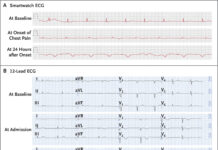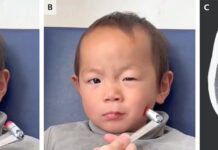Stroke after a trip to a beauty salon/hairdresser!

A 45-year-old father of two girls, a resident of England, named Dave Tyler, was brought to the hospital after his body got numb and he collapsed in the middle of a business meeting. The patient had a constant headache before his presentation to the hospital.
He told:
“The whole side of my body went numb, and while waiting for the ambulance, my eyes went ping and started rolling. This made me nauseous so I was sick. I took a swig of water without knowing I’d lost the ability to swallow. The water wasn’t going anywhere and I couldn’t breathe. And because I wasn’t able to swallow, I ingested some of the vomit into my lungs and developed pneumonia.”
The patient gave a history of a visit to a hairdresser 2 days before his symptoms began. His head was washed in the salon’s sink by extending the neck to tilt the head backwards in the sink. The patient denied feeling discomfort or any symptoms while his head was being washed in the sink.
Dave Tyler, the sound engineer, spent 3 months in the hospital to recover enough to be discharged, and in total, he spent 5 months to get back on his feet with the support of a stick. The unfortunate consequences of a salon visit costed him 5 months and a lifetime of inability to drive due to the residual visual complications (double vision).
The doctors believed that his vertebral artery (artery in the neck) ripped while bending the neck backwards over the basin. The ripping of the artery must have restricted the blood supply to the brain. Doctors believe he suffered a stroke after the blood clot burst, which consequently led to smaller clots in his brain.
He was diagnosed with beauty parlor syndrome or vertebrobasilar insufficiency.
Beauty parlor stroke syndrome occurs secondary to the neck’s hyperextension, or improperly bending the head back for a long period, most commonly due during hair washing at the salon. This syndrome isn’t new; it was first given this name in 1993, but it existed even before that. Although rare, it can have life-threatening or long-term complications.
Dr. Robert Coni, medical director of the stroke program at HCA’s Grand Strand Medical Center in Myrtle Beach, S.C., explained:
“Sometimes the blood vessels in the spinal canal are extra-long and can get ‘kinked’ by the pressure placed there. This can create a bulge in the interior wall of the artery that effectively blocks blood flow or causes a compressive injury to the artery.”
The altered flow in the artery can lead to neurological symptoms, such as headache, dizziness, motor or sensory dysfunction, muscle weakness, visual disturbances, etc.
Dr. Coni said:
“The first description of this may have been in the 1970s, and there were several cases in the early 90s, too. But, early on, the only way we could look at the arteries in the back of the neck was through angiography – an invasive procedure that required threading a catheter to the brain – and was not routinely performed due to the morbidity associated with it.”
With age, the risk of BPS syndrome increases due to the increased likelihood of arthritis in the neck.
How to prevent?
No, not going to the salon is not the answer here.
The answer here is not in a single sentence but it is surely as simple as ABC
First and foremost, it is best to have knowledge of the syndrome. Then, a simple precaution is to ensure effective neck support while bending the neck back over the sink, such as a roll of a towel.
Dr. Coni advised:
“Really, the best advice is to request a shampoo with your head bent forward rather than backward. If that’s not possible, the most important thing you can do is speak up if you’re uncomfortable.”
Speaking up and aborting as soon as one is uncomfortable is imperative. It is equally crucial to raise awareness and take prompt action if a glimpse of symptoms is seen as the brain loses approximately 1.8 million cells every minute a stroke is left untreated.
Salon owners should also be educated regarding the BPS syndrome, its complications, and precautions so that they can protect their clients!
References:
The European Stroke Initiative Executive Committee and the EUSI Writing Committee: European stroke initiative recommendations for stroke management – Update 2003. Cerebrovasc Dis 2003; 16: 311–337
Shimura H, Yuzawa K, Nozue M: Stroke after a visit to the hairdresser. Lancet 1997; 350: 1778.




